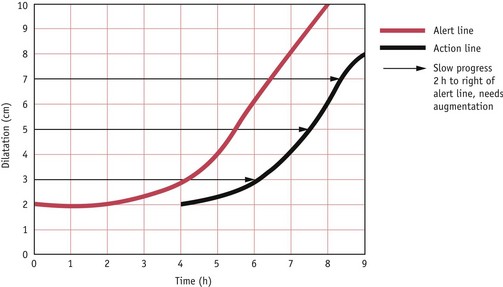Chapter 63 Rhythmic variations of labour
After reading this chapter, you will be able to:
Introduction
This chapter looks at prolonged labour and explores the issues that surround altered uterine action; prevention, diagnosis, management and associated problems. To maximize learning, it is anticipated that the reader has a working knowledge of the underlying physiology, care and management of normal labour (Chs 35–37).
In normal labour, the uterine contractions become progressively longer, stronger, and increase in frequency, causing the complete effacement and progressive dilatation of the os uteri in the first stage, steady delivery of the baby in the second stage, and expulsion of the placenta and membranes and the control of haemorrhage to complete the third stage of labour (Ch. 35).
The partogram
The partogram is an observation chart that may be used to facilitate assessment of the progress of labour, including maternal and fetal wellbeing (Ch. 37). Historically, progress is measured by linear progression along a prescribed time scale, whereby a curve of cervical dilatation is measured in centimetres plotted against time in hours (Friedman 1955), and descent of the head abdominally. Over the years, modifications to the partogram have occurred, resulting in the introduction of alert and action lines. Originally, the action line was 2 hours to the right of the alert line, and augmentation instituted at this time (Fig. 63.1). Once labour is confirmed as in the active phase, cervical dilatation is expected to progress at <2 cm dilatation in 4 hours (NICE 2008). Albers (2007) supports this as a realistic expectation; she goes on to say that for some women, progress may be as little as 0.3 cm per hour. Clearly this demonstrates that partograms are only a tool and the progress of labour should not be assessed upon cervical effacement and dilation alone, without the assessment of the descent of the presenting part abdominally. Behaviour is shown to be a key part in normal progression alongside one-to-one care by a midwife.
To maximize use, NICE (2008) recommends that, if a partogram is used, it should record all of the following observations:
Prolonged labour
The term ‘prolonged labour’ is difficult to define, since it is dependent upon the actual time at which labour is presumed to have begun; therefore, accurate history is essential. Enkin et al (2000) suggest that the most frequently used marker for the onset of labour for women choosing a hospital birth is the time of admission. Since this is an arbitrary measurement, it can lead to an inaccurate diagnosis of the onset of labour. The presumed failure of the cervix to dilate within a given time limit based on the inaccurate diagnosis of labour, may result in the use of inappropriate intervention, preventing the woman from following her own labour pattern.
The majority of women whose labours are prolonged are primigravidae, with inefficient uterine action being the most common cause (El-Hamamy & Arulkumaran 2005). The birth of the first child alters the birth canal and subsequent deliveries are usually easier, since the mother has the potential benefits of experience and belief in herself.
Causes of prolonged labour
Any one of these factors, or a combination of them, may cause prolonged labour, which remains a major cause of maternal death and infant morbidity in developing countries (Berhane & Hogberg 1999).
Dangers to the mother
Dangers to the fetus
Prolonged labour is associated with fetal acidosis and intrauterine hypoxia, which can result in meconium aspiration and may lead to perinatal dealth (MCHRC 2000).




